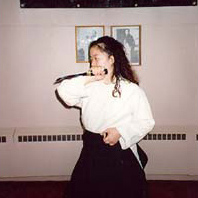|
The Art of the Dagger
|
Fujiyama Dojo P.O. Box 20003 Thorold, ON, Canada L2V 5B3 (905) 680-6389 |
|---|
 Tantojutsu, or the art of the knife or dagger, has a no less prominent place in the history of bujutsu than its illustrious relative, the Nihon-To or Japanese sword.
Most styles of ko-ryu bujutsu included knife techniques in their curriculum, and skill in its use was considered to be a necessity for the swordsman. The texts that describe the tanto as a samurai weapon for indoor use are not incorrect, but incomplete. It is true that many techniques using the knife are depicted in old scrolls when describing zaho (seated system), and in comparable numbers, are shown as defense against surprise attacks while in seiza (a good example would be the techniques of Take No Uchi ryu). But with equal frequency we find, in different ryu, tanto waza as defense against sword attacks, or even against such a formidable opponent as a spear (as in ancient Kiraku ryu, for instance), and the old accounts related to the hozoin spear.
The arts taught in the Aizu were no different. The use of the knife was not a rare art by any means and consequently, Tantojutsu is an inherent part of Daito ryu traditions. The techniques include the usage of the knife as well as defenses against knife attacks. Formal tanto, as well as women's daggers, are used in almost identical forms, although the weapon's placement in the obi differs between women and men. Men do not usually practice the sode, or sleeve techniques.
The tanto, by concept of usage, is not just a cutting weapon, since its techniques include parrying, deflecting, striking, joint locking, choking, and pinning. Although its waza are not as numerous as its better known counterpart, the sword, tanto technique do not lack in functionality nor in grace. and remain an important part of ko-ryu bujutsu. Tantojutsu, or the art of the knife or dagger, has a no less prominent place in the history of bujutsu than its illustrious relative, the Nihon-To or Japanese sword.
Most styles of ko-ryu bujutsu included knife techniques in their curriculum, and skill in its use was considered to be a necessity for the swordsman. The texts that describe the tanto as a samurai weapon for indoor use are not incorrect, but incomplete. It is true that many techniques using the knife are depicted in old scrolls when describing zaho (seated system), and in comparable numbers, are shown as defense against surprise attacks while in seiza (a good example would be the techniques of Take No Uchi ryu). But with equal frequency we find, in different ryu, tanto waza as defense against sword attacks, or even against such a formidable opponent as a spear (as in ancient Kiraku ryu, for instance), and the old accounts related to the hozoin spear.
The arts taught in the Aizu were no different. The use of the knife was not a rare art by any means and consequently, Tantojutsu is an inherent part of Daito ryu traditions. The techniques include the usage of the knife as well as defenses against knife attacks. Formal tanto, as well as women's daggers, are used in almost identical forms, although the weapon's placement in the obi differs between women and men. Men do not usually practice the sode, or sleeve techniques.
The tanto, by concept of usage, is not just a cutting weapon, since its techniques include parrying, deflecting, striking, joint locking, choking, and pinning. Although its waza are not as numerous as its better known counterpart, the sword, tanto technique do not lack in functionality nor in grace. and remain an important part of ko-ryu bujutsu.
|
|---|


